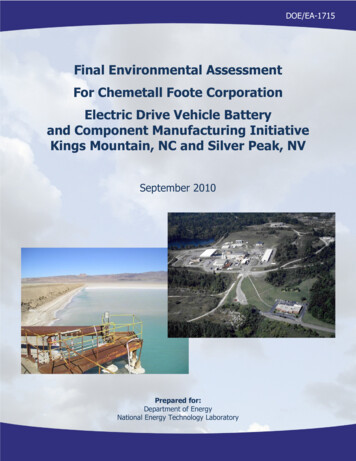
Transcription
DOE/EA-1715Final Environmental AssessmentFor Chemetall Foote CorporationElectric Drive Vehicle Batteryand Component Manufacturing InitiativeKings Mountain, NC and Silver Peak, NVSeptember 2010Prepared for:Department of EnergyNational Energy Technology Laboratory
This page intentionally left blank.
Electric Drive Vehicle Battery andComponent Manufacturing Initiative ProjectChemetall Foote Corporation, Kings Mountain, NC and Silver Peak, NVDOE/EA-1715Environmental AssessmentSeptember 2010National Environmental Policy Act (NEPA) ComplianceCover SheetProposed Action:The U.S. Department of Energy (DOE) proposes, through a cooperative agreement with Chemetall FooteCorporation (Chemetall) to partially fund: (1) the establishment of a new 5,000 metric ton per year lithiumhydroxide plant at an existing Chemetall facility in Kings Mountain, North Carolina; and (2) the refurbishmentand expansion of an existing lithium brine production facility and lithium carbonate plant in Silver Peak, Nevada.Both projects would support the anticipated growth in the electric drive vehicle (EDV) industry and hybridelectric vehicle (HEV) industry. If approved, DOE would provide approximately 45 percent of the funding forthe project.Type of Statement: Final Environmental Assessment (EA)Lead Agency:U.S. Department of Energy (DOE); National Energy Technology Laboratory (NETL)DOE Contact:NEPA Information:William GwilliamNEPA Document ManagerU.S. Department of EnergyNational Energy Technology Laboratory3610 Collins Ferry Road, P.O. Box 880Morgantown, WV 26507-0880304-285-4401; 304-285-4403 (fax)William.gwilliam@netl.doe.govProject Information:Dr. Christopher JohnsonProject ManagerU.S. Department of EnergyNational Energy Technology Laboratory3610 Collins Ferry Road, P.O. Box 880Morgantown, WV 26507-0880304-285-4718; 304-285-4403 (fax)cjohnson@nelt.doe.govAbstract:DOE prepared this EA to assess the potential for impacts to the human and natural environment of its proposedaction to provide financial assistance to Chemetall under a cooperative agreement. DOE’s objective is to supportthe development of the Electric Drive Vehicles (EDV) industry in an effort to reduce the United States’consumption of petroleum, in addition to stimulating the United States’ economy. More specifically, DOE’sobjective is to accelerate the development and production of various EDV systems by building or increasingdomestic manufacturing capacity for advanced automotive batteries, their components, recycling facilities, andEDV components. This work will enable market introduction of various electric vehicle technologies by loweringthe cost of battery packs, batteries, and electric propulsion systems for EDVs through high-volumemanufacturing.Under the terms of the cooperative agreement, DOE is to provide approximately 45 percent of the funding forChemetall to establish a new 5,000 metric tons per year lithium hydroxide plant at an existing Chemetall facilityin Kings Mountain, North Carolina and to upgrade and expand an existing lithium brine production facility and anexisting lithium carbonate plant in Silver Peak, Nevada.The Kings Mountain site is located in an industrial area directly south of Kings Mountain, in Cleveland County,North Carolina, and serves as the headquarters for Chemetall. The site is located on 720 acres, with theoperations concentrated within an approximately 20-acre developed area that is centrally located within theproperty. Production currently includes a specialty lithium manufacturing plant, which produces various lithiumsalt products by reacting lithium carbonate with different materials to produce lithium bromide, lithium chloride,and lithium aluminate. The proposed project would expand operations at the facility by adding a lithiumhydroxide plant. The project at Kings Mountain would create approximately 19 25 permanent jobs.
Electric Drive Vehicle Battery andComponent Manufacturing Initiative ProjectChemetall Foote Corporation, Kings Mountain, NC and Silver Peak, NVDOE/EA-1715Environmental AssessmentSeptember 2010The Silver Peak site is approximately 15,000 acres. Chemetall uses the Silver Peak site for the production oflithium carbonate, and to a lesser degree, lithium hydroxide from lithium-bearing brines that are pumped from awell field. Silver Peak is the only major source of lithium carbonate in the United States. The proposed projectwould rework the existing brine field’s production system, rework and expand the capacity of the existing brineevaporation pond system, and refurbish the existing lithium carbonate plant. All the improvements would occurwithin Chemetall’s patented mining claims. The project at Silver Peak would create approximately 14 10permanent jobs.Chemetall may also construct a geothermal power plant in the western portion of its Silver Peak unpatentedmining claims. However, that action would be evaluated separate EAs prepared by the Bureau of LandManagement (BLM) and is not part of this EA.The environmental analysis identified that the most notable changes, although minor, to result from Chemetall’sproposed project would occur in the following areas: air quality, solid and hazardous wastes, and human healthand safety for both Kings Mountain and Silver Peak, with the exception of solid and hazardous waste for SilverPeak, which was negligible. Additionally for Silver Peak, minor impacts would occur to groundwater,transportation and traffic. No significant environmental effects were identified in analyzing the potentialconsequences of these changes.Public Participation:DOE encourages public participation in the NEPA process. This EA was released for public review andcomment. The public were invited to provide oral, written, or e-mail comments on this Draft EA to DOE by theclose of the comment period on June 9, 2010. Copies of the Draft EA were also distributed to cognizant Federaland State agencies. Comments received by the close of the comment period were considered in preparing thisFinal EA for the proposed DOE action. Therefore, the EA was revised were appropriate to address agency andpublic comments, and thus additions and revisions to the text are presented in italics and underlined, whiledeleted text is presented as strike-through. Public comments received on the EA and responses are provided inAppendix B. The EA is also available on DOE website at http://www.netl.doe.gov /publications/others/nepa/ea.html.
Electric Drive Vehicle Battery andComponent Manufacturing Initiative ProjectChemetall Foote Corporation, Kings Mountain, NC and Silver Peak, NVDOE/EA-1715Environmental AssessmentSeptember 2010TABLE OF CONTENTSACRONYMS . iii1.0PURPOSE AND NEED .11.1Background .11.2Purpose and Need for Department of Energy Action .11.3National Environmental Policy Act and Related Procedures .21.4Agency Consultation and Public Involvement .32.0PROPOSED ACTION AND ALTERNATIVES .52.1Department of Energy’s Proposed Action .52.2Chemetall’s Proposed Project .52.3General Description and Location .62.3.1 Kings Mountain .62.3.2 Silver Peak.62.4Alternatives .102.5No Action Alternative .112.6Alternatives Considered by Chemetall .112.7Summary of Environmental Consequences.113.0AFFECTED ENVIRONMENT AND ENVIRONMENTAL CONSEQUENCES .133.1Resource Areas Dismissed from Further Consideration .133.1.1 Kings Mountain .133.1.2 Silver Peak.183.2Resource Areas Considered Further .303.2.1 Air Quality and Greenhouse Gas.303.2.1.1 Affected Environment .333.2.1.1.1 Kings Mountain .333.2.1.1.2 Silver Peak .343.2.1.2 Environmental Consequences .353.2.1.2.1 No Action Alternative.353.2.1.2.2 Proposed Project .363.2.1.2.3 Cumulative Impacts .373.2.1.2.4 Proposed Mitigation Measures .373.2.2 Solid and Hazardous Wastes .383.2.2.1 Affected Environment .383.2.2.1.1 Kings Mountain .383.2.2.1.2 Silver Peak .403.2.2.2 Environmental Consequences .413.2.2.2.1 No Action Alternative.413.2.2.2.2 Proposed Project .423.2.2.3 Cumulative Impacts .433.2.2.4 Proposed Mitigation Measures.443.2.3 Human Health and Safety.443.2.3.1 Affected Environment .443.2.3.1.1 Kings Mountain .443.2.3.1.2 Silver Peak .453.2.3.2 Environmental Consequences .453.2.3.2.1 No Action Alternative.453.2.3.2.2 Proposed Project .453.2.3.3 Cumulative Impacts .47i
Electric Drive Vehicle Battery andComponent Manufacturing Initiative ProjectChemetall Foote Corporation, Kings Mountain, NC and Silver Peak, NV3.2.3.4DOE/EA-1715Environmental AssessmentSeptember 2010Proposed Mitigation Measures.474.0REFERENCES .495.0LIST OF PREPARERS .536.0DISTRIBUTION LIST .55LIST OF TABLESTable 2.6-1.Table 3.1.1-1.Table 3.1.2-1.Table 3.2.1-1.Table 3.2.1-2.Table 3.2.1-3.Table 3.2.1-4.Table 3.2.2-1.Table 3.2.2-2.Table 3.2.2-3.Summary of Environmental, Cultural, and Socioeconomic Impacts . 12Study Area Soils at Kings Mountain. 14Study Area Soils at Silver Peak . 20National, North Carolina, and Nevada Ambient Air Quality Standards . 31Allowable PSD Increments (µg/m3) . 32Actual and Potential Emissions (tpy) from Kings Mountain . 34Actual and Potential Emissions (tpy) from Silver Peak . 35Quantities of Materials Stored on Site – Kings Mountain Facility . 38Wastes Generated at Kings Mountain Facility 1,2 . 39Quantities of Materials Stored on Site – Silver Peak Facility . 40LIST OF FIGURESFigure 2-1. Regional Location Map – Kings Mountain, North Carolina .7Figure 2-2. Regional Location Map – Silver Peak, Nevada .8Figure 2-3. Site Location Map – Silver Peak, Nevada .9Figure 3-1. Flow Path Lines that Start at a Time-of-Travel Distance of Ten Years away from the Well Heads forSilver Peak Wells, W01, W02 plus Chemetall Foote Well FWW#2.25Figure 3-2. Delineated *2-, 5- and 10-Year Wellhead Protection Areas .26LIST OF APPENDICESAppendix A – Agency ConsultationAppendix B – Public Comments on the Draft Environmental Assessment and Responses from the Department ofEnergy and Chemetall Foote Corporationii
Electric Drive Vehicle Battery andComponent Manufacturing Initiative ProjectChemetall Foote Corporation, Kings Mountain, NC and Silver Peak, NVDOE/EA-1715Environmental AssessmentSeptember os containing materialAPEArea of Potential EffectAQRVair quality related valuesASTaboveground storage tankBMPbest management practicesBLMBureau of Land ManagementCAAClean Air ActCEcategorically excludedCEQCouncil on Environmental QualityCERCLAComprehensive Environmental Response Compensation and Liability ActCFRCode of Federal RegulationsCH4methaneChemetallChemetall Foote CorporationCOcarbon monoxideCO2carbon dioxideDAQDivision of Air QualityDOEDepartment of EnergyEAEnvironmental AssessmentEDVelectric drive vehiclesEEREEnergy Efficiency and Renewable EnergyEISEnvironmental Impact StatementEPAUnited States Environmental Protection AgencyEPCRAEmergency Planning and Community Right-to-Know ActFFahrenheitFEMAFederal Emergency Management AgencyFIRMFlood Rate Insurance MapFONSIFinding of No Significant ImpactGHGgreenhouse gasesIInterstateHAPhazardous air pollutantsLEPCLocal Emergency Planning CommitteeLi2CO3lithium carbonateLiOHlithium hydroxidemgmilligramMMtmillion metric tonsMMtCO2emillion metric tons of carbon-dioxide equivalentmtpymetric tons per yeariii
Electric Drive Vehicle Battery andComponent Manufacturing Initiative ProjectChemetall Foote Corporation, Kings Mountain, NC and Silver Peak, NVDOE/EA-1715Environmental AssessmentSeptember 2010AcronymNAAQSDefinitionNational Ambient Air Quality StandardsNCACNorth Carolina Administrative CodeNCDENRNorth Carolina Department of Environment and Natural ResourcesNDCNRNevada Department of Conservation and Natural ResourcesNDEPNevada Department of Environmental ProtectionNEPANational Environmental Policy ActNETLNational Energy Technology LaboratoryNO2nitrogen dioxideNOxnitrogen oxidesNPLNational Priorities ListNRSNevada Revised StatutesO3ozonePCSpetroleum contaminated soilPMparticulate matterPM10particulate matter 10 micronsPM2.5particulate matter 2.5 micronsPPEpersonal protective equipmentppmparts per millionPSDprevention of significant deteriorationPwPits, quarryRCRAResource Conservation and Recovery ActRecovery ActAmerican Recovery and Reinvestment Act of 2009, Public Law 111-5RODRecord of DecisionSIPState Implementation PlanSO2sulfur dioxideSPCCSpill Prevention Countermeasures and ControlSERCState Emergency Response CommitteeTPHtotal petroleum hydrocarbonstpytons per yearTSDtreatment, storage and disposalU.S.United StatesU.S.C.United States CodeUdCUdorthents, loamyUSACEUnited States Army Corps of EngineersUSFWSUnited States Fish and Wildlife ServiceVOCsvolatile organic compoundsVTVehicle Technologiesiv
Electric Drive Vehicle Battery andComponent Manufacturing Initiative ProjectChemetall Foote Corporation, Kings Mountain, NC and Silver Peak, NV1.0PURPOSE AND NEED1.1BackgroundDOE/EA-1715Environmental AssessmentSeptember 2010The Department of Energy’s (DOE’s) National Energy Technology Laboratory (NETL) manages the research anddevelopment portfolio of the Vehicle Technologies (VT) Program for the Office of Energy Efficiency andRenewable Energy (EERE). A key objective of the VT program is accelerating the development and productionof electric drive vehicle (EDV) systems to reduce the United States’ consumption of petroleum. Another of itsgoals is the development of production-ready batteries, power electronics, and electric machines that can beproduced in volume economically to increase the use of EDVs.Congress appropriated significant funding for the VT program in the American Recovery and Reinvestment Actof 2009, Public Law 111-5 (Recovery Act) to stimulate the economy and reduce unemployment in addition tofurthering the existing objectives of the VT program. DOE solicited applications for this funding by issuing acompetitive Funding Opportunity Announcement (DE-FOA-0000026), Recovery Act - Electric Drive VehicleBattery and Component Manufacturing Initiative, on March 19, 2009. The announcement invited applications inseven areas of interest: Area of Interest 1 – Projects that would build or increase production capacity and validate productioncapability of advanced automotive battery manufacturing plants in the United States.Area of Interest 2 – Projects that would build or increase production capacity and validate productioncapability of anode and cathode active materials, components (e.g., separator, packaging material,electrolytes and salts), and processing equipment in domestic manufacturing plants.Area of Interest 3 – Projects that combine aspects of Areas of Interest 1 and 2.Area of Interest 4 – Projects that would build or increase production capacity and validate capability ofdomestic recycling or refurbishment plants for lithium ion batteries.Area of Interest 5 – Projects that would build or increase production capacity and validate productioncapability of advanced automotive electric drive components in domestic manufacturing plants.Area of Interest 6 – Projects that would build or increase production capacity and validate productioncapability of electric drive subcomponent suppliers in domestic manufacturing plants.Area of Interest 7 – Projects that combine aspects of Areas of Interest 5 and 6.The application period closed on May 19, 2009, and DOE received 119 proposals across the seven areas ofinterest. DOE selected 30 projects based on the evaluation criteria set forth in the funding opportunityannouncement; special consideration was given to projects that promoted the objectives of the Recovery Act – jobpreservation or creation and economic recovery – in an expeditious manner.This project, proposed by Chemetall Foote Corporation (Chemetall), was one of the 30 projects that DOE selectedfor funding. DOE’s proposed action is to provide 17.8 16.1 million in financial assistance in a cost-sharingarrangement with the project proponent, Chemetall. The total cost of the project is estimated at 35.6 million.1.2Purpose and Need for Department of Energy ActionThe overall purpose and need for DOE action pursuant to the VT program and the funding opportunity under theRecovery Act is to accelerate the development and production of various EDV systems by building or increasingdomestic manufacturing capacity for advanced automotive batteries, recycling facilities, and EDV components, inaddition to stimulating the United States’ economy. This work will enable market introduction of various electricvehicle technologies by lowering the cost of battery packs, batteries, and electric propulsion systems for EDVsthrough high-volume manufacturing. DOE intends to further this purpose and satisfy this need by providingfinancial assistance under cost-sharing arrangements to this and the other 29 projects selected under this fundingopportunity announcement.1
Electric Drive Vehicle Battery andComponent Manufacturing Initiative ProjectChemetall Foote Corporation, Kings Mountain, NC and Silver Peak, NVDOE/EA-1715Environmental AssessmentSeptember 2010This and the other selected projects are needed to reduce the United States’ petroleum consumption by investingin alternative VTs. Successful commercialization of EDVs would support DOE's Energy Strategic Goal of“protect[ing] our national and economic security by promoting a diverse supply and delivery of reliable,affordable, and environmentally sound energy." This project will also meaningfully assist in the nation’seconomic recovery by creating manufacturing jobs in the United States in accordance with the objectives of theRecovery Act.1.3National Environmental Policy Act and Related ProceduresThis Environmental Assessment (EA) is prepared in accordance with the National Environmental Policy Act(NEPA), as amended (42 U.S.C 4321), the President’s Council on Environmental Quality (CEQ) regulations forimplementing NEPA (40 Code of Federal Regulations [CFR] 1500-1508), and DOE’s implementing proceduresfor compliance with NEPA (10 CFR 1021). This statute and the implementing regulations require that DOE, as aFederal agency: Assess the environmental impacts of any proposed action;Identify adverse environmental effects that cannot be avoided, should the proposed action beimplemented;Evaluate alternatives to the proposed action, including a No Action Alternative; andDescribe the cumulative impacts of the proposed action together with other past, present, and reasonablyforeseeable future actions.These provisions must be addressed before a final decision is made to proceed with any proposed Federal actionthat has the potential to cause impacts to the human environment, including providing Federal funding to aproject. This EA evaluates the potential individual and cumulative effects of the proposed project and the NoAction Alternative on the physical, human, and natural environment. The EA is intended to meet DOE’sregulatory requirements under NEPA and provide DOE with the information needed to make an informeddecision about providing financial assistance.NEPA requires Federal agencies to take into account the potential consequences of their actions on both thenatural and human environments as part of their planning and decision-making processes. To facilitate theseconsiderations, a number of typical actions that have been determined to have little or no potential for adverseimpacts are “categorically excluded” (CE) from the detailed NEPA assessment process. Thus, the first step indetermining if an action would have an adverse effect on the environment is to assess whether it fits into a definedcategory for which a CE is applicable. If a CE is applied, the agency prepares a Record of Categorical Exclusionto document the decision and proceeds with the action.For actions that are not subject to a CE, the agency prepares an EA to determine the potential for significantimpacts. If through the evaluation and analysis conducted for the EA process, it is determined that no significantimpacts would occur because of the action, then the determination would result in a Finding of No SignificantImpact (FONSI). The Federal agency would then publish an EA and the FONSI. The NEPA process is completewhen the FONSI is executed.If significant adverse impacts to the natural or human environment are indicated or other interveningcircumstances either exist at the onset of a project or are determined through the EA process, an EnvironmentalImpact Statement (EIS) may be prepared. An EIS is a more intensive study of the effects of the proposed action,and requires more rigorous public involvement. The agency formalizes its decisions relating to an action forwhich an EIS is prepared in a Record of Decision (ROD). Following a 30-day waiting period after publication ofthe Final EIS, the Agency may issue a ROD and then the NEPA process is complete.2
Electric Drive Vehicle Battery andComponent Manufacturing Initiative ProjectChemetall Foote Corporation, Kings Mountain, NC and Silver Peak, NV1.4DOE/EA-1715Environmental AssessmentSeptember 2010Agency Consultation and Public InvolvementDOE conducted consultations with the local U.S. Fish and Wildlife Service (USFWS) office, the NationalHeritage Program office in each State, and the State Historic Preservation Office of each State per requirements ofSection 7 of the Endangered Species Act, and Section 106 of the National Historic Preservation Act. Copies ofthe agency response letters are included in Appendix A of this EA.3
Electric Drive Vehicle Battery andComponent Manufacturing Initiative ProjectChemetall Foote Corporation, Kings Mountain, NC and Silver Peak, NVThis page intentionally left blank.4DOE/EA-1715Environmental AssessmentSeptember 2010
Electric Drive Vehicle Battery andComponent Manufacturing Initiative ProjectChemetall Foote Corporation, Kings Mountain, NC and Silver Peak, NV2.0PROPOSED ACTION AND ALTERNATIVES2.1Department of Energy’s Proposed ActionDOE/EA-1715Environmental AssessmentSeptember 2010DOE proposes, through a cooperative agreement with Chemetall, to partially fund two projects that wouldproduce or increase production of battery-grade lithium salts to be used in lithium-ion batteries. (1) A newlithium hydroxide plant would be established at an existing Chemetall building in Kings Mountain, NorthCarolina, and (2) an existing lithium carbonate plant, evaporation pond system, and lithium brine field would berefurbished and expanded in Silver Peak, Nevada. Both projects would support the anticipated growth in theEDV industry and HEV industry. If approved, DOE would provide approximately 45 percent of the funding forthe two projects.2.2Chemetall’s Proposed ProjectChemetall proposes (1) to establish and operate a new lithium hydroxide plant at an existing Chemetall facility inKings Mountain, North Carolina and (2) to upgrade an existing brine field production system, brine evaporationpond system, and lithium carbonate plant in Silver Peak, Nevada.The Kings Mountain proposed project would produce 5,000 metric tons per year of lithium hydroxide usingconventional technology for reacting lithium carbonate with lime and purifying, drying and packaging the productfor sale to the battery industry. This plant would be setup within an existing building owned by Chemetall andlocated within Chemetall’s existing industrial complex. Currently, the existing building is approximately 58 feetin height and would be extended two floors (30 feet) with a final building height of approximately 88 feet. A newaddition of 8,200 square feet would be connected to the existing building at grade level for a packaging room, anda 15-foot wide by 60-foot long covered aisle-way would be constructed between the new packaging room and theexisting warehouse. As part of the project, a concrete walled tank farm containing six new aboveground storagetanks (ASTs) would be erected adjacent to the proposed plant building. Four ASTs would be 21 feet in height(two at 13,700 gallons and two at 18,900 gallons); the fifth would be 39 feet in height (32,600 gallons); and thesixth would be 18.5 feet in height (11,600 gallons). The evaporator feed tank and the evaporator, crystallizerboilout tank would both contain weak lithium hydroxide solution that would be stored in the 13,700-gallon ASTs.Process condensate water and the weak liquor tank liquids (weak lithium hydroxide solution) would be stored inthe 18,900 gallon ASTs. The 36,200-gallon tank
in Kings Mountain, North Carolina and to upgrade and expand an existing lithium brine production facility and an existing lithium carbonate plant in Silver Peak, Nevada. The Kings Mountain site is located in an industrial area directly south of Kings Mountain, in Cleveland County, Nort










